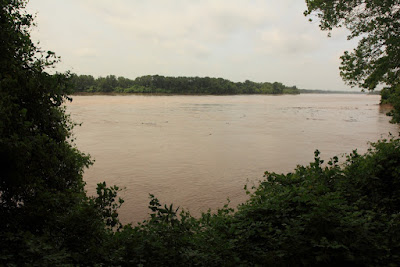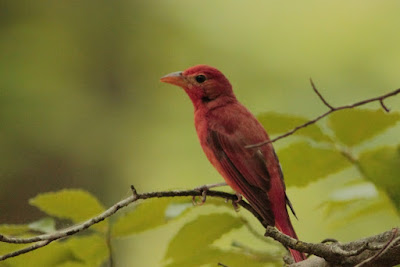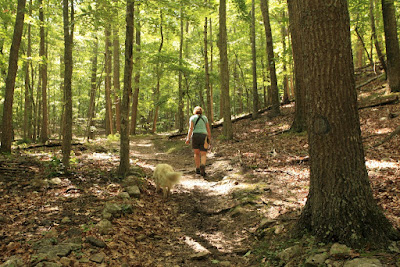When we awoke it was later than we thought as we had just crossed into the central time zone. Horned Larks and Lark Sparrows were foraging in the grass beside the RV. The Nebraska prairie expanded around us like a beautiful verdant rolling carpet.
We drove the short distance to Fort Niobrara National Wildlife Refuge and crossed the scenic NioBrara River.
Fort Niobrara National Wildlife Refuge
This river is designated as a National Scenic River and the tranquil lush landscape did not disappoint.
Niobrara National Scenic River
Across the Niobrara the wildlife refuge opened up into a wide meadow and we found ourselves in the midst of a large prairie dog town. The RV acts a perfect blind as the animals have minimal reaction to the large vehicle rolling toward them. I pulled my 600 mm lens from the back and poked it out the window for an extended photo session. Emma was used to this and settled back by the kitchen window to read her book.
Our RV acting as a blind beside a Prairie Dog Town
The curious prairie dogs were all around and easy to see as they keep the grass nice and short throughout their town.
"What's that" said Emma as she looked up from her book. Sharp eyed Emma had spotted an Upland Sandpiper wandering through the prairie dog town. Like Mountain Plovers, the Upland Sandpiper is adapted to the short grass ecosytem created by prairie dogs. This was a lifer bird for me so I proceed to fire off several dozen photos.
Upland Sandpiper
To celebrate we went on a hike along the banks of the Niobrara River. The trail was beautiful with lush grasses on the bank and large trees overhanging the river. However, we were in for a big surprise.
When we returned to the RV Sonaa had a dozen wood ticks crawling through her fur. We immediately wrestled Sonaa to the ground and started to pluck the bugs from her body before they became embedded.
The more we looked the more wood ticks appeared out of her thick white fur.
You have wood ticks on you as well exclaimed, Emma! We stopped focusing on the dog and did a thorough examination of each other. Sure enough I had 6 wood ticks climbing up my body and Emma had one.
We carried on south through Nebraska stopping every few hours to continue our wood tick inspection. Sonaa's wood tick count kept going up as more of the little blighters kept appearing. We were shocked when the count reached 25, blown away when it topped 40 and speechless when the final wood tick count for the day was:
Sonaa 52, Jim 7 and Emma 2.
With a background in science, I readily arrived at the hypothosis that the more hirsute the subject the greater the propensity to attract wood ticks. Good thing Sonaa got those Lyme Disease shots.
Valentine National Wildlife Refuge
We had lunch at the Valentine National Wildlife Refuge and finished the day at a Walmart in Lexington.
What a day. Thoroughly inspecting Sonaa for wood ticks was not a lot of fun but inspecting each other had its moments.
June 21
It was another beautifully blue-sky, hot summer day as we drove through central Nebraska, first south to North Platte then east to Lincoln. Turning south again we arrived at Homestead National Monument at noon.
The Homestead Act of 1862 granted 160 acres of free land to claimants. It was one of the most significant and far reaching events in the westward expansion of the United States. Homestead National Monument of America commemorates this Act.
Typical Prairie Cabin
We walked around the grounds of this thought provoking monument. The landscape and ecosystems of the west was fundamentally altered by the Homestead Act. Where once there were thousands of miles of tall and short grass prairie now there are thousands of miles of cultivated farm land. This is great for human food production but not so good for the wildlife that had evolved over the millennia to live in tall and short grass prairie ecosystems. Now wildlife is largely restricted to a few patches of preserved prairie ecosystems in parks and reservations.
Natural habitat loss is compounded by insecticides leaching into the food chain. First DDT and now neonicotinoids are killing off insects. Even if you create habitat pockets for ducks it does no good for the birds when the insecticides leach into the pond and kill their food source.
Farming Equipment from the 19th Century
With miles to go, we descended into Kansas through Marysville to Highway 70 then east. We saw a lot of wide open prairie farm land on this sunny spring day.
Barn Swallow Nest
Nightfall found us in another Walmart just east of Kansas City.
June 22
We had lots of ground to cover so it was time to motor across the verdant green prairie of central Missouri. At Boonville, we visited Katy Trail State Park for our mid day exercise. This trail is 200 miles of converted railway and ideal for bicycles. Naturally. Emma rented a bike and charged off along the trail while Sonaa and I leisurely bird watched along the bank of the Missouri River.
Missouri River at Boonville
87) Indigo Bunting
There were several Indigo Buntings in the bushes as well as a 88) Yellow-billed Cuckoo that perched for a moment.
Eastern Phoebe
Back on the road the prairie became move treed with small farms dotting the landscape. As we approached Saint Louis the traffic pace and volume steadily increased.
Our drive through Saint Louis was intense. Emma spotted our new interstate hook-up at the last second. I pulled the RV hard right to make the turn. The driver on my right, who was not intending to make the turn, had little choice but to join us. Oops.
In anticipation of the intense driving around St. Louis, Emma had already taken her Adivan. Even so, I received an ear full over my latest maneuver. Fortunately, the heavy freeway traffic slowed to a dead stop then crawled along and we were able to regain our equilibrium. Busch Stadium and the Gateway Arch slowly rolled by on our left but this was not the occasion for me to break our the camera gear and fire off a few shots. Emma was still in recovery mode.
After crossing the Mississippi and leaving the suburbs of Saint Louis we pulled over at a rest stop and watched a newly fledged Robin exploring its world.
Fledgeling American Robin
We carried on along Interstate 64 then down Interstate 57. We finished a long hard day of driving when we pulled into the Arrowhead Lake Campground in Johnston City. It was a very pleasant end to the day as this lovely campground was beside a treed lake and the cost was only $12 per vehicle.
June 23
The weather was hot and humid and best suited to staying in an air conditioned RV. We decided to enjoy this delightful campground and stay another day. A two mile shoreline walk circumnavigated a small lake adjacent to the campground. The birding was excellent as we enjoyed morning and evening strolls through the shady path around the lake.
We saw: 89) Great Crested Flycatcher, 91) Red-belled Woodpecker, 92) Downy Woodpecker, 94) Great Blue Heron 95) Blue-winged Warbler, 96) Carolina Wren and 97) Northern Cardinal.
Eastern Cottontail
Great White-fronted Goose
Great-crested Flycatcher
June 24It was another clear hot day but not as muggy as the day before. After a short drive south we stopped at a Forest Ranger Station near Vienna to get directions into the forest. Following his directions we ended up in a secluded part of Shawnee National Forest. I was hoping to see wood warblers but little was moving in the dense bush. Fortunately, one juvenile 98) Kentucky Warbler kept peeking out of the foliage to get a better look at us. Unfortunately, his parents kept calling to him to return to the dense foliage.
Red-spotted Purple (imenitis arthemis astyanax)
After driving through a thousand miles of open prairie the forests of Illinois and Kentucky were impressive. At the Kentucky Visitor Centre we saw 99) Northern Mockingbird and 100) Brown Thrasher.
We carried on toward Mammoth Cave Kentucky and stopped at a Walmart in Bowling Green.
June 25
The day started out hot and humid and climbed from there. It was a short drive to Mammoth Caves. We arrived early and got the last full hook-up in the campground. Immediately, we parked then plugged in the air conditioner. It was a life saver.
The outside heat and humidity were beyond anything we had experienced. It felt like you needed a machete to cut your way through the hot blocks of humid air as you attempted to move forward. However, feeling a sense of duty to the dog we took her outside for her morning walk. Sonaa immediately walked into the forest, dug a shallow trench in the moist earth and lay down. Good idea Emma and I said in unison and returned to the air conditioned RV.
Still its hard to keep an avid birder down so I did a short tour of the campground while Emma settled into a good book in the RV. Despite the 99 degree heat and the 100 percent humidity, I enjoyed the beautiful surrounding of this Kentucky Forest. The woods were alive with the trumpeting of Wood Thrushes belting out their melodious songs. It was good to see this endangers species in such large numbers.
When I was a young boy in Winnipeg, a Wood Thrush had its nest in the forest 50 yards from my front door. Since then the Wood Thrush population has been in sharp decline and its nesting range has shrunk back to the south east USA.
101) Wood Thrush
102)* Summer Tanager
Surprise, a Summer Tanager suddenely appeared out of the forest, checked me out then flew off. Luckily, I had my camera at the ready and fired off a few quick shots.
American Robin
American Robins were also about in large numbers and seemed unaffected by the heat.
Later in the day, we walked over to the cave site and booked our Mammoth Cave tour for tomorrow.
June 26
It rained last night and took some of the humidity out of the air. This changed the heat and humidity from unbearable to moderately intolerable. We sauntered down to the Mammoth Cave Visitor Centre for our 10:00 a.m. tour. There are more than 400 miles of explored caves at this site. Our tour covered two miles and took two hours.
We descended a forest path to the cave entrance and you could feel the heat and humidity dissipate as we descended. In the cave, it was cool and even a bit cold.
Entrance to Mammoth Cave
The Mammoth Cave has many large vaulted rooms but no stalactites or stalagmites and the cave walls were bare. The tour guide kept the walk interesting as she explained some of the history associated with Mammoth Cave.
Mammoth Cave
Historically, tens of thousands of bats lived in the cave. In the past, bat guano was thick on the floor and commercially mined for years.
As we left the cave I was surprised to see the disinfecting foot pads at the exit. At all the other caves we visited, the disinfecting measures were at the cave entrance. Then we realized that the white nose infection has already decimated the bat population at Mammoth Cave. Here the safety measures have been reversed.
June 27
To exiting Mammoth, we took the quieter Flint Road exit. At an old church we stopped to look for wood warblers but had no luck.
Traveling along Interstate 64 we passed by Lincoln Birthplace National Historic Park and stopped in for a visit.
The 56 steps up the monument represent the 56 years of Abraham Lincoln's life. It was a moving experience.
Lincoln believed and stated " If slavery is not wrong then nothing is wrong". He did not waver from this fundamental belief regardless of the cost in blood that was required to pull his nation out of slavery.
Every nation in history has ultimately fallen and drifted back into the sands of time as new nations arise. To survive and prosper a nation needs to be able to change and adapt constantly. At a terrible cost, the USA was able to discard one of the primary tenants of its early existence.
How well will the nation meet the current challenges of global warming, gun control, petroleum dependence, the metric system, simplistic fundamentalist religions of every description, wealth inequality, and corporations influencing the electoral system? Time will tell.
Lincoln's Frontier Cabin
We carried on through Lexington followed Interstate 64 into West Virginia. At the Walmart in Hurricane, we stopped for the night.June 28
It was a sunny pleasantly warm day as we drove through the beautiful rolling deciduous forests of West Virginia. Verdant hilltops were interspersed between steep even greener valleys.
New River Gorge National River
At the New River Gorge National River, we stopped in at the Sandstone Visitor Cener for information and to enjoy the views. The New River was winding its way through the lush scenic West Virginia hills.
New River
The forested slopes of the gorge were dotted with meadows that had opened up the forest canopy. In addition, to the great views we got a fleeting glimpse of two (105) Scarlet Tanagers high in the tree tops and (106) Wild Turkeys in the underbrush. It is late June but the male Scarlet Tanagers were already showing green patches as they started to molt back to basic plumage.
Meadow Beside the New River
Looking for a good place to hike we carried on to Douthat State Park in Virginia. This picturesque little park has numerous interesting hikes through a quiet deciduous landscape.
Wilson Creek
We started beside Wilson Creek and followed the Blue Suck Trail up the side of a well forested mountain. Emma was in her element and strode resolutely through the warm shady forest.
Emma on Blue Suck Falls Trail
Blue Suck Falls Trail
Sonaa and I followed at a more leisurely pace as there is always one more picture to take or stream to explore.
Sonaa has a refreshing dip in every creek
Blue Suck Falls
We reached our hiking destination at Blue Suck Falls and enjoyed a refreshing break beside the banks of this delightful mountain stream. By nightfall, we were at the Walmart in Staunton, Virginia.

















































































